Did you know that driver fatigue contributes to approximately 13% of all commercial motor vehicle crashes? That’s a staggering statistic that underscores why the Department of Transportation’s Hours of Service (HOS) rules exist! These federal regulations aren’t just bureaucratic red tape—they’re literally lifesavers designed to keep our roads safe while ensuring drivers get adequate rest.
Whether you’re a seasoned truck driver, fleet manager, or new to the commercial driving world, understanding HOS rules is absolutely crucial for legal compliance and operational success. I’ll walk you through everything you need to know about these complex regulations, from basic driving limits to electronic logging requirements. Let’s dive into the essential guide that could save you from costly violations and help you master the road ahead!
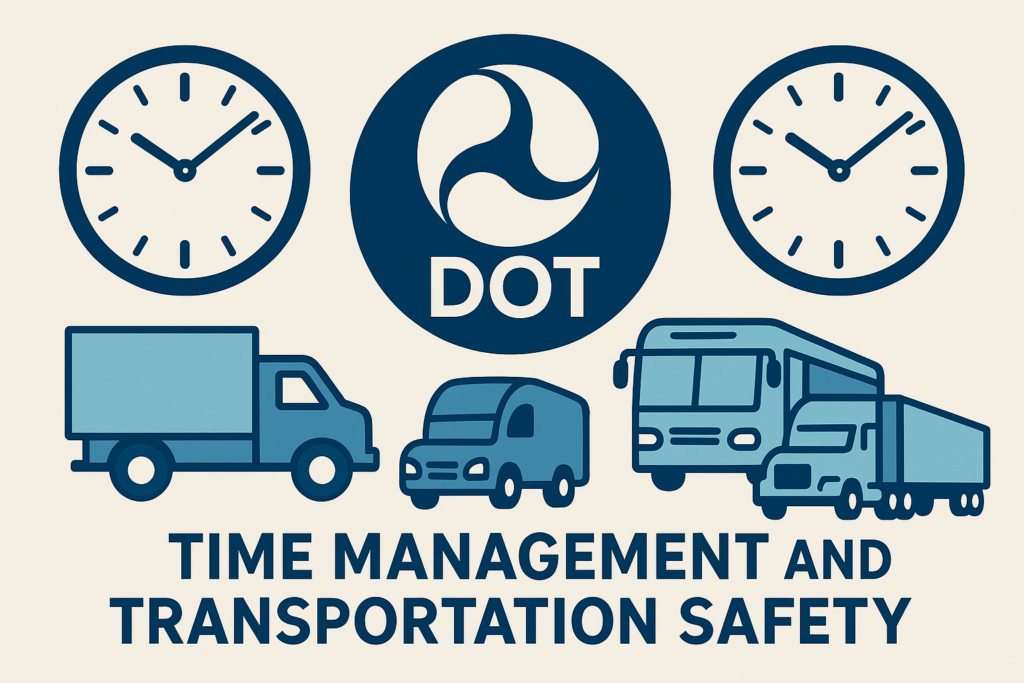
The Federal Motor Carrier Safety Administration (FMCSA) established Hours of Service regulations to combat driver fatigue and improve road safety for everyone. These rules apply to commercial motor vehicle (CMV) drivers who operate vehicles with a gross vehicle weight rating of 10,001 pounds or more, transport hazardous materials, or carry 16 or more passengers including the driver.
The regulations differ significantly between property-carrying vehicles (freight trucks) and passenger-carrying vehicles (buses, motorcoaches). Recent updates in 2020 provided additional flexibility while maintaining safety standards, including modified short-haul exemptions and adverse driving condition extensions.
[Learn more about CDL requirements and commercial vehicle classifications]
“Hours of Service rules aren’t just regulations—they’re the guardrails that keep our industry moving safely down the road of success.”
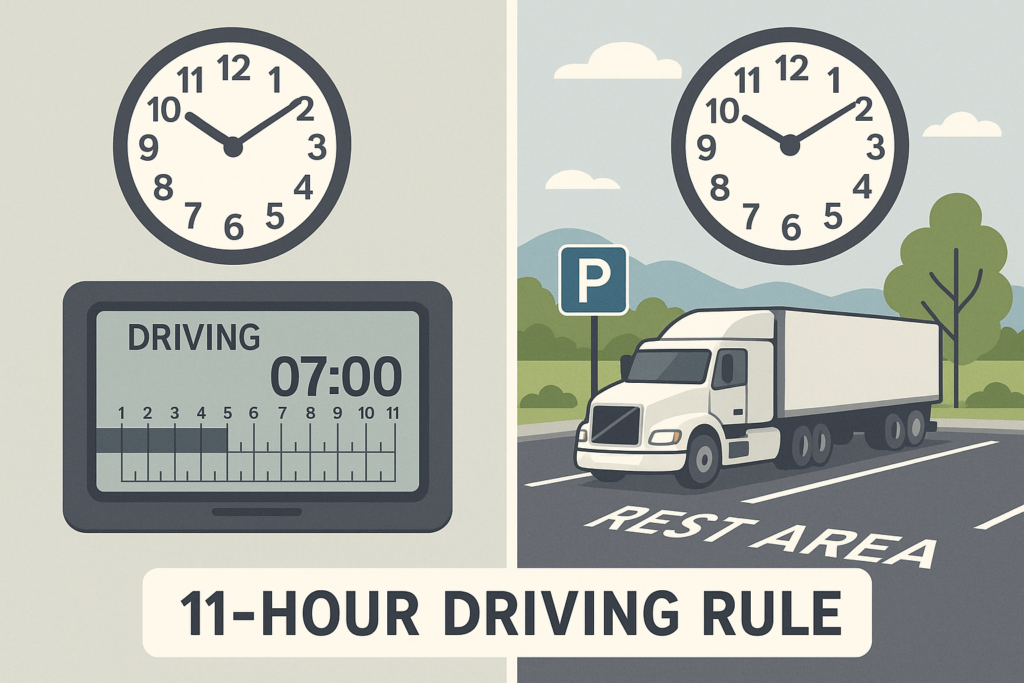
For property-carrying commercial vehicles, the core HOS rules revolve around several key time limits that work together to ensure adequate rest:
Drivers may drive a maximum of 11 hours after coming on duty following 10 or more consecutive hours off duty. This driving time doesn’t have to be continuous but cannot exceed 11 hours total before requiring another 10-hour break.
Drivers cannot drive beyond the 14th consecutive hour after coming on duty, regardless of off-duty time taken during those 14 hours. This rule creates a “window” within which all driving must be completed. Once the 14-hour window expires, drivers must take at least 10 consecutive hours off duty before driving again.
Drivers cannot drive after being on duty for 60 hours in any 7 consecutive days, or 70 hours in any 8 consecutive days. Drivers working for carriers that operate every day of the week use the 70-hour/8-day limit.
Drivers must take a 30-minute break when they have driven for a period of 8 cumulative hours without at least a 30-minute interruption. The break may be satisfied by any non-driving period of 30 minutes or more.
The sleeper berth rule allows drivers to split their required 10-hour off-duty time into two periods: one of at least 7 consecutive hours in the sleeper berth, and another of at least 2 consecutive hours either off duty or in the sleeper berth. This flexibility helps drivers optimize their schedules around delivery appointments and traffic patterns.
[Understanding ELD compliance requirements for fleet managers]
Related: Learn more about ELD compliance requirements and pre-trip inspection procedures
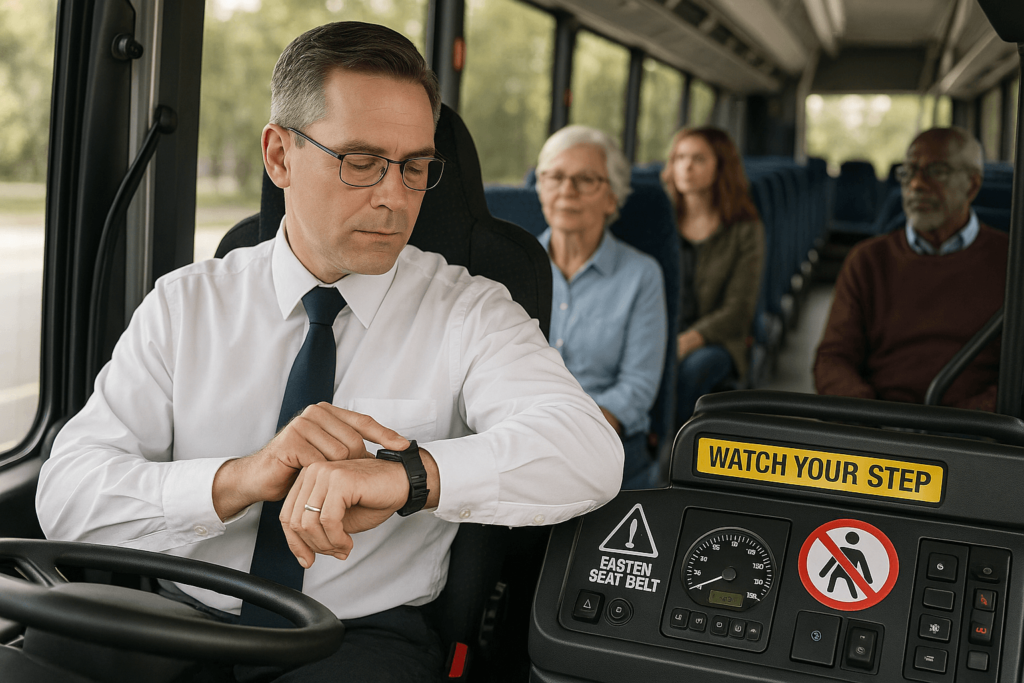
Passenger-carrying vehicles operate under slightly different HOS rules that reflect the unique responsibilities of transporting people:
Drivers may drive for no more than 10 hours following 8 consecutive hours off duty. This shorter driving period acknowledges the additional stress and responsibility of passenger transportation.
Drivers may not drive after having been on duty for 15 hours, following 8 consecutive hours off duty. Unlike property-carrying vehicles, this rule allows for a longer on-duty window to accommodate passenger loading, route delays, and customer service responsibilities.
Similar to property-carrying vehicles, passenger carriers cannot drive after 60 hours on duty in 7 consecutive days or 70 hours in 8 consecutive days, depending on their operation schedule.
While passenger-carrying vehicles aren’t subject to the 30-minute rest break rule that applies to property carriers, drivers must still comply with other rest and meal break requirements that may be mandated by state laws.
Special considerations apply to different types of passenger operations, including scheduled route service, charter operations, and tour bus services. Each may have specific exemptions or additional requirements based on the nature of their service.
[Commercial vehicle inspection requirements and safety protocols]
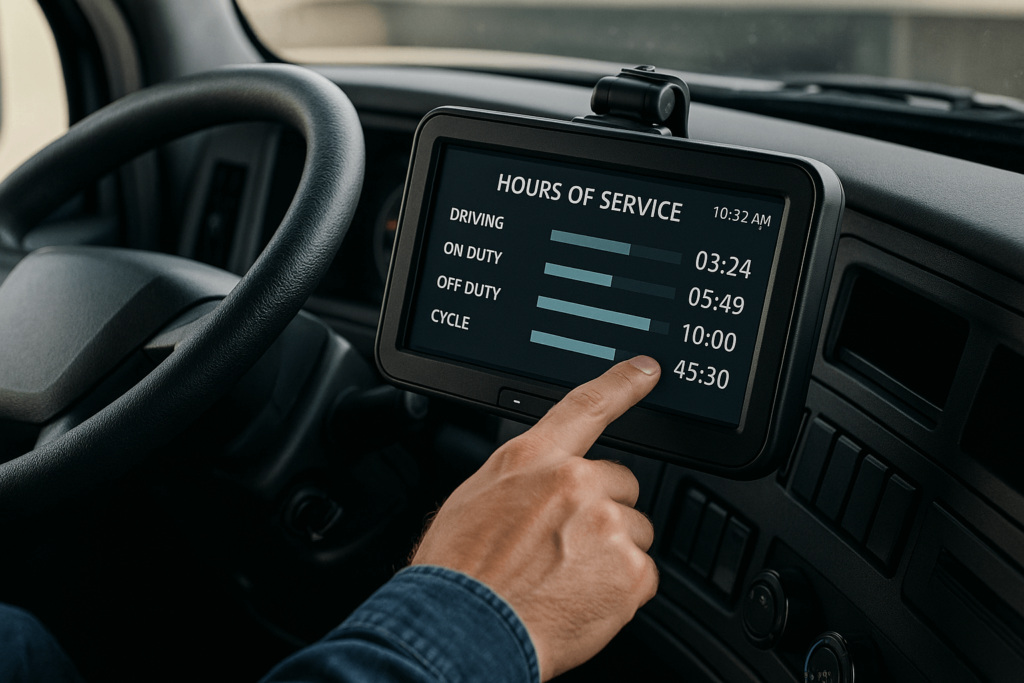
The ELD mandate, fully implemented in December 2017, revolutionized HOS compliance by requiring electronic recording of driving time and duty status. Understanding ELD requirements is crucial for legal operation:
Most commercial drivers subject to HOS rules must use ELDs to record their duty status. The devices automatically record driving time, engine hours, vehicle movement, miles driven, and location information.
Certified ELDs must provide specific data elements including date, time, location, engine hours, vehicle miles, and duty status. The device must allow drivers to review and edit records when necessary, with annotations explaining any changes
Drivers must ensure their ELD is functioning properly, review their logs for accuracy, and certify their records. When ELD malfunctions occur, drivers must continue recording their hours using paper logs and note the malfunction.
During roadside inspections, drivers must be able to display or transfer their ELD records to enforcement officials. This includes current day logs and the previous seven days of records.
Drivers must carry blank log books to use during ELD malfunctions. When technical issues arise, drivers have specific time limits to repair or replace their ELD while maintaining compliant records.
The benefits of ELD compliance extend beyond regulatory requirements, including improved scheduling accuracy, reduced paperwork, and better fleet management capabilities.
[Top ELD providers and fleet management software solutions]
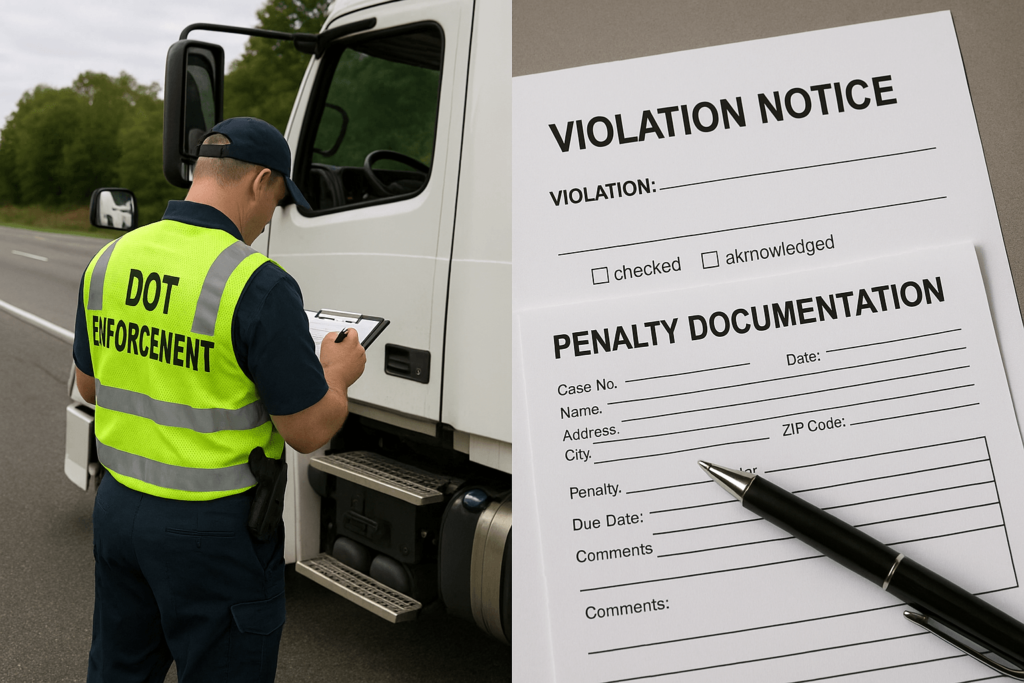
HOS violations carry serious consequences that can impact both individual drivers and motor carriers. Understanding the penalty structure helps emphasize the importance of compliance:
The FMCSA can assess civil penalties up to $16,864 per violation for drivers and up to $16,864 per violation for motor carriers. Serious violations can result in multiple citations, quickly escalating penalty amounts.
Drivers found in violation of HOS rules may be placed out of service immediately, meaning they cannot drive until they’ve accumulated sufficient off-duty time to be in compliance. This can strand drivers and delay shipments significantly.
HOS violations contribute to a carrier’s Compliance, Safety, Accountability (CSA) score in the Hours of Service BASIC category. High scores can trigger increased inspections, compliance reviews, and ultimately affect a carrier’s ability to operate.
Repeated HOS violations can lead to CDL suspension or revocation. Drivers who accumulate multiple serious violations within specific timeframes face progressive penalties that can end their driving careers.
Many carriers have zero-tolerance policies for certain HOS violations. Even first-time violations can result in termination, making it difficult to find employment with reputable companies.
HOS violations in connection with accidents can increase liability exposure and insurance costs. Courts may view violations as evidence of negligence in civil proceedings.
Prevention remains the best strategy—investing in proper training, planning tools, and compliance systems costs far less than dealing with violations and their consequences.
[How to improve your CSA scores and maintain DOT compliance]

Several exemptions and special circumstances provide flexibility in HOS compliance for specific industries and situations:
During planting and harvest seasons, agricultural operations receive extended HOS flexibility. Drivers transporting agricultural commodities within 150 air miles of their source may be exempt from certain requirements during these critical periods.
Natural disasters, emergencies, and other unforeseen circumstances can trigger temporary HOS relief. The FMCSA may issue emergency declarations that provide additional flexibility for drivers responding to crisis situations.
Certain construction and utility vehicles may qualify for exemptions when responding to emergencies or performing essential infrastructure work. These exemptions typically have specific conditions and geographic limitations.
The 100 air-mile and 150 air-mile short-haul exemptions allow qualifying drivers to operate without ELDs and with modified HOS requirements. These exemptions have specific conditions regarding duty time, geographic range, and record-keeping.
Drivers serving oil and gas fields may qualify for special HOS provisions, including extended on-duty time and modified rest requirements. These rules recognize the unique operational demands of energy sector transportation.
Understanding exemption requirements is crucial—improperly claiming an exemption can result in violations. Drivers and carriers should carefully review eligibility criteria and maintain proper documentation to support exemption claims.
[Guide to DOT exemptions and special permits for commercial operations]

Successful HOS compliance requires proactive planning and systematic approaches that go beyond simply following the rules:
Effective drivers plan their routes considering HOS limitations, traffic patterns, and delivery schedules. Using route planning software that incorporates HOS rules helps optimize efficiency while maintaining compliance.
Understanding how different activities affect duty status helps drivers maximize their available hours. Knowing when activities count as on-duty versus off-duty time can provide additional flexibility.
Modern fleet management systems can monitor HOS compliance in real-time, alerting drivers and dispatchers to potential violations before they occur. Investing in these tools prevents costly mistakes.
HOS rules evolve, and staying current with regulatory changes is essential. Regular training programs help drivers understand nuances and avoid common mistakes that lead to violations.
Maintaining accurate records goes beyond ELD compliance. Proper documentation of duty status changes, vehicle inspections, and unusual circumstances provides protection during compliance reviews.
While HOS rules provide minimums for rest, individual drivers may need additional rest to operate safely. Recognizing personal fatigue patterns and planning accordingly improves both safety and compliance.
Establishing clear communication protocols between drivers and dispatch helps prevent situations where drivers might feel pressured to violate HOS rules to meet unrealistic schedules.
[Essential trucking apps and technology tools for drivers]

Even experienced drivers make HOS mistakes that can lead to violations. Understanding common errors helps prevent costly compliance issues:
Many drivers incorrectly believe they can extend their 14-hour window by taking breaks. The 14-hour rule is consecutive time from when a driver comes on duty, regardless of off-duty time taken during that period.
The split sleeper berth provision is complex, and drivers often miscalculate when they can drive again after splitting their rest period. Both the 7/3 and 8/2 splits have specific requirements that must be met exactly.
Using personal conveyance to move a commercial vehicle for personal reasons has strict limitations. Many violations occur when drivers use this status inappropriately to extend their driving time or avoid parking restrictions.
Drivers sometimes fail to properly record on-duty time while loading, unloading, or waiting for loads. These activities typically count as on-duty time and must be accurately recorded.
Feeling pressured to meet unrealistic delivery schedules sometimes leads drivers to exceed HOS limits. Understanding that safety regulations take precedence over delivery demands is crucial.
Some drivers confuse state-specific requirements with federal HOS rules. Federal regulations typically take precedence for interstate commerce, but understanding local requirements prevents additional complications.
Avoiding these mistakes requires vigilance, proper training, and commitment to safety over convenience.
[Complete guide to commercial vehicle inspections and compliance audits]

Mastering hours of service rules isn’t just about avoiding fines—it’s about building a sustainable, safe, and profitable driving career! These regulations may seem complex, but they’re designed with your safety and well-being in mind. From the 11-hour driving limit to ELD compliance, every rule serves a purpose in preventing fatigue-related accidents.
Remember, staying compliant with HOS regulations protects not only your CDL and livelihood but also every person sharing the road with you. Take the time to understand these rules thoroughly, invest in proper planning tools, and never hesitate to take that required rest break. Your safety, your career, and countless lives depend on it.
The transportation industry continues evolving, with technology making compliance easier while regulations adapt to operational realities. Drivers who embrace these changes and maintain high compliance standards position themselves for long-term success in an industry that values safety and professionalism.
Ready to implement these HOS strategies? Start by reviewing your current compliance practices and consider investing in quality ELD technology and training programs. Safe driving isn’t just a slogan—it’s a commitment to excellence that begins with understanding and following hours of service rules!
For more comprehensive trucking industry insights, compliance guidance, and career development resources, explore our complete library of professional driving content. Stay safe, stay compliant, and keep trucking!
[CDL career advancement guide] | [Fleet safety management best practices] | [DOT compliance checklist for drivers]
We’re here to keep your trucking business moving forward. Reach out to us with any inquiries, service requests, or partnership opportunities. Let’s grow together!

Let Clear Path Trucking LLC. be your trusted partner in navigating the road to success. Whether you’re an owner-operator or managing a fleet, we’re here to help you take your trucking business to the next level.
Subscribe to receive industry updates and tips directly in your inbox
© Copyright 2024 Clear Path Trucking LLC. - All Rights Reserved.